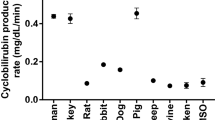Abstract
THE conjugation of bilirubin to its glucuronides in rat liver homogenates was studied, using boiled liver extract1, uridine diphosphoglucuronic acid (UDPGA), uridine diphosphoglucose (UDPG) with diphosphopyridine nucleotide (DPN+), or the system consisting of uridine triphosphate (UTP) with glucose-1-phosphate (G–1–P), and diphosphopyridine nucleotide as sources of the glucuronosyl radical. The effects of various substances on the formation of bilirubin glucuronides from bilirubin are listed in Table 1. Under the conditions used in these experiments, liver homogenates hydrolysed 5.7 per cent of added phenolphthalein glucuronide (0.42 mM) in 30 min., this hydrolysis being inhibited (44.5 per cent) by 5.5 mM potassium glucuronate, and even more (90 per cent) by 1.1 mM boiled potassium hydrogen saccharate. Both these substances exhibited marked enhancing effects on the formation of a fraction of bilirubin giving the direct van den Bergh diazo reaction. Bacterial β-glucuronidase (100 units) added to the incubation mixture almost abolished the bilirubin conjugation. The acceleration of this conjugation by glucuronate offers a plausible explanation for the effect of treatment of neonatal hyperbilirubinæmia with glucuronic acid2. Lathe and Walker3 reported an inhibitory effect of glucuronate on the synthesis of bilirubin glucuronide in rat liver slices. The liver slices technique shows results different in some respects from those obtained with whole-liver homogenates. Grodsky et al.4, working with liver homogenates, and with methods essentially similar to those described here, reported that no hydrolysis of 2 × 10−5 M phenolphthalein glucuronide occurred in their experiments, and that no activation of bilirubin conjugation could be observed with saccharate. Brown et al.5, referring to the experiments of Karunairatnam et al. (see ref. 5) with liver slices, also deny that β-glucuronidase plays any part in producing hyperbilirubinæmia of the new-born. It has now been clearly demonstrated that in neonatal jaundice the deficiencies of glucuronosyl transferase3–5 and of uridine diphosphoglucose dehydrogenase5 are essentially responsible for the increase of serum bilirubin-levels. Ethylenediamine tetraacetate increased the production of bilirubin conjugates.
This is a preview of subscription content, access via your institution
Access options
Subscribe to this journal
Receive 51 print issues and online access
$199.00 per year
only $3.90 per issue
Buy this article
- Purchase on Springer Link
- Instant access to full article PDF
Prices may be subject to local taxes which are calculated during checkout
Similar content being viewed by others
References
Dutton, G. J., and Storey, I. D. E., Biochem. J., 57, 275 (1954).
Danoff, S., Grantz, C., Boyer, A., and Holt, jun., L. E., Science, 127, 759 (1958).
Lathe, G. H., and Walker, M., Quart. J. Exp. Physiol., 43, 257 (1958).
Grodsky, G. M., Carbone, J. V., and Fanska, R., Proc. Soc. Exp. Biol. Med., 97, 291 (1958).
Brown, A. K., Zuelzer, W. W., and Burnett, H., J. Clin. Invest., 37, 332 (1958).
Clark, V. M., Kirby, G. W., and Todd, A., Nature, 181, 1650 (1958).
Talafant, E., and Továrek, J., Cas. lék. ces. (in the press); Vnitr. lék. (in the press).
Author information
Authors and Affiliations
Rights and permissions
About this article
Cite this article
TALAFANT, E., TOVÁREK, J. Factors affecting the Rate of Bilirubin Conjugation in vitro. Nature 183, 111–112 (1959). https://doi.org/10.1038/183111b0
Issue Date:
DOI: https://doi.org/10.1038/183111b0
Comments
By submitting a comment you agree to abide by our Terms and Community Guidelines. If you find something abusive or that does not comply with our terms or guidelines please flag it as inappropriate.



